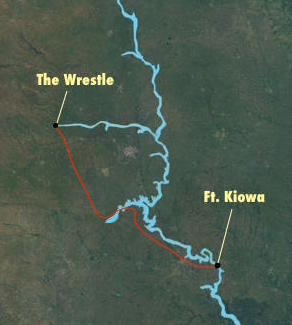Fort Kiowa facts for kids
Fort Kiowa, also known as Fort Lookout, was an important fur trading post in the 1800s. It was built along the Missouri River in what is now South Dakota, between modern-day Chamberlain, South Dakota, and the Big Bend area of the river.
The fort was built in 1822 by the Columbia Fur Company. It was a large square fort, about 140 feet by 140 feet. It served as a vital rest stop and trading place for trappers and famous explorers like Jim Bridger and Hugh Glass. By the early 1840s, the fur trade moved further west, and Fort Kiowa was left empty. Today, the spot where the fort once stood is underwater, beneath the man-made Lake Sharpe.
Contents
Building Fort Kiowa
After the Louisiana Purchase in 1803, the United States became much larger. People quickly wanted to explore and profit from the new lands, especially through the fur trade. Trading posts, or "forts," started appearing along rivers and trails.
At first, the government tried to run a trading system where Native American tribes could trade furs for goods at special forts. However, this system didn't work very well. The people running the forts weren't experienced traders, and private companies soon became much more successful.
Rich businessmen like Manuel Lisa of the Missouri Fur Company and John Jacob Astor of the American Fur Company became very wealthy from the fur trade. These private companies built many forts that acted as rest stops for trappers and traders. Fort Kiowa was one of the most well-known.
Early Days of the Fort
Joseph Brazeau Jr. built Fort Kiowa in 1822. It was a large complex, about 20,000 square feet. He added a blockhouse and a watchtower to protect against attacks from tribes like the Crow people and Sioux.
Fort Kiowa became famous as the starting point for a big trading trip in 1823, known as "Ashley's Hundred." This group included famous trappers Hugh Glass and Jim Bridger.
The Story of Hugh Glass
During the 1823 journey, Hugh Glass was attacked by a grizzly bear. He managed to kill the bear but was badly hurt. Two of his companions were told to stay with him until he died and then bury him. However, they left him alone, thinking he would not survive.
One of the companions, Jim Bridger, returned to the main group and reported that Glass had died. But Hugh Glass was incredibly tough! He survived, set his own wounds, and crawled more than 200 miles back to Fort Kiowa. His amazing journey is a famous story of survival in the American West.
Changes and Challenges
In 1827, Bernard Pratte bought Fort Kiowa. He made big improvements, adding several log houses, a storehouse, and a smith shop. Pratte also built a tall wooden fence, about twenty or thirty feet high, around the fort to protect it from Native American attacks. With these changes, Fort Kiowa became a major trading post for local tribes.
Later that same year, John Jacob Astor bought Fort Kiowa from Pratte. Astor was one of the richest men in America and wanted to control the fur trade in the upper Missouri River area. He found this region to be very profitable.
Decline of the Fur Trade
However, by the late 1830s, Astor's American Fur Company had to leave Fort Kiowa. The fur trading business was no longer making much money for a few reasons:
- There were fewer beavers because trappers had hunted too many.
- People in America and Europe started wanting silk hats instead of beaver fur hats.
- American trappers were moving onto land that Native American tribes felt was theirs, which led to conflicts.
As the demand for furs dropped and fewer animals were available, the fur trade in America began to disappear.
In 1840, Joseph LaBarge, a former steamboat captain, bought Fort Kiowa. He planned to use it as a winter home and a place for "Indian Agents." These agents were supposed to manage trade between Native American tribes and Euro-Americans. However, many people thought these agents were corrupt and only cared about themselves. LaBarge's plan for Fort Kiowa didn't work out, and he abandoned it within a year. He was the last known person to live at Fort Kiowa.
Fort Kiowa Today
Today, Fort Kiowa is underwater, likely beneath Lake Francis Case, a reservoir created by a dam. The area where the fort once stood is recognized as a National Historic Fort in South Dakota. Some people even advertise it as a place where adventure-seeking tourists can follow the same path Hugh Glass took in 1823.
The 2015 movie The Revenant is based on the incredible true story of Hugh Glass.



